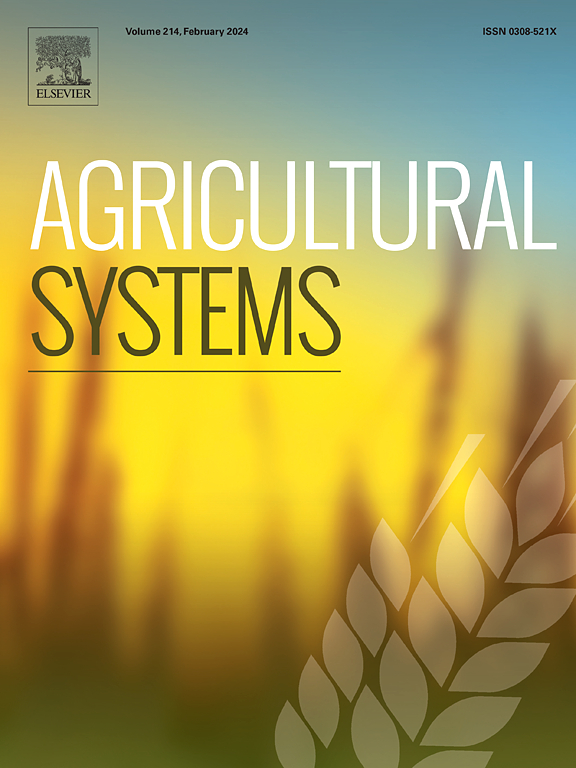谷物种植农场实现净零排放的途径
IF 6.1
1区 农林科学
Q1 AGRICULTURE, MULTIDISCIPLINARY
引用次数: 0
摘要
市场和社会越来越需要能够更好地平衡生产、利润和环境结果的粮食生产系统。在谷物种植农场实现净零排放的替代途径有望在可持续农业的多个方面(如利润、环境、社会和风险)带来好处和权衡。目的:(i)整合全农场模型的能力来模拟从摇篮到农场的大门边界温室气体排放;(ii)使用全农场模型来估计在历史和预期的未来气候情景下,澳大利亚昆士兰州三个案例研究农场实现NetZero的途径之间的权衡;(iii)分析澳大利亚昆士兰州主要粮食种植区的场地条件对温室气体排放、毛利率(GM)、风险的影响。以及对补偿的需求。方法通过专家咨询和文献分析,我们对整个农场建模框架APSFarm NextGen进行了参数化,并量化了粮食农场的NetZero路径。该模型用于模拟六种农场管理策略,包括:(i)机会主义策略,(ii)刚性策略,(iii)传统的高投入策略,(iv)保护策略,(v)农业生态学策略,以及(vi)使用植树造林作为补偿的NetZero方法。历史气候(1970-2019)和2021-2070年气候预估与三个共享社会经济路径(SSP): SSP126、SSP245和SSP585一起使用。我们评估了场地条件,即土壤和气候,毛利率,下行风险和温室气体排放。结果与结论本文测试的减缓策略降低了温室气体排放强度,但无法实现净零排放。在三个案例研究地点中,4%到14%的农场面积需要植树造林才能实现零NetZero。NetZero策略显示,平均比基线策略(机会主义和刚性策略)低10.5%的GM。根据2024年第一季度的价格,这一经济影响相当于2.98个澳大利亚碳信用单位。在未来的气候情景下,实现零净农场将需要更大的造林面积。环境因子影响产出:温室气体排放与平均气温、年降水量和土壤容重呈正相关。正如预期的那样,GM与干旱指数正相关,即湿润环境中GM较高。下行风险,即实现负回报的概率,与干旱指数呈负相关,即在湿润环境中风险较低。在澳大利亚的谷物农场实现净零排放可能需要抵消排放并考虑到较低的利润。模型产出可用于为农业实现零净的途径中经济和环境结果之间的预期权衡提供信息。APSFarm NextGen模型可以很容易地适用于其他粮食生产系统、国家和地区。本文章由计算机程序翻译,如有差异,请以英文原文为准。

Pathways towards Net Zero emissions in grain cropping farms
CONTEXT
Markets and society increasingly demand food production systems that better balance production, profits, and environmental outcomes. Alternative pathways towards achieving NetZero emissions in grain cropping farms can be expected to have benefits and trade-offs across the multiple dimensions of sustainable agriculture, e.g., profits, environment, society and risks.
OBJECTIVES
To (i) incorporate capabilities in a whole-farm model to simulate cradle-to-farm gate boundary greenhouse gas emissions, (ii) use a whole-farm model to estimate trade-offs between pathways towards NetZero on three case study farms of Queensland Australia under historical and expected future climate scenarios, and (iii) analyse the influence of site conditions across the main grain growing regions of Queensland Australia on GHG emissions, gross margin (GM), risks, and the need for offsets.
METHODS
Using expert consultations and literature analysis we parameterised the whole farm modelling framework APSFarm NextGen and quantified NetZero pathways for grain farms. The model was used to simulate six farm management strategies, including (i) opportunistic, (ii) rigid, (iii) conventional high input strategy, (iv) conservation, (v) agroecology, and (vi) a NetZero approach that used afforestation as an offset. Historical climate (1970–2019), and 2021–2070 climate projections were used together with three Shared Socioeconomic Pathways (SSP): SSP126, SSP245, and SSP585. We assessed site conditions i.e., soil and climate, on gross margin, downside risks, and GHG emissions.
RESULTS AND CONCLUSIONS
The mitigation strategies tested here reduced GHG emission intensities but wouldn't achieve Net Zero emissions. Across three case study sites, between 4 % and 14 % of the farm area would need to be afforested to achieve NetZero. NetZero strategies showed, on average, 10.5 % lower GM than the baseline strategies (opportunistic and rigid strategy). This economic impact is equivalent to 2.98 Australian Carbon Credit Units, based on Q1 2024 prices. Under future climate scenarios, achieving NetZero farms will require larger afforestation areas. Environmental factors influenced the outputs: GHG emissions were positively correlated with mean air temperatures, annual precipitation, and soil bulk density. As expected, GM was positively correlated with an aridity index i.e., higher GM in wetter environments. Downside risk, i.e., the probability of achieving a negative return, was negatively correlated with aridity index, i.e., lower risks in wetter environments.
SIGNIFICANCE
Achieving NetZero in Australia's grain farms is likely to require offsetting emissions and factoring in lower profits. Model outputs could be used to inform expected trade-offs between economic and environmental outcomes in agriculture's pathways towards NetZero. The APSFarm NextGen model can be easily adapted to be applied to other grain production systems, countries, and regions.
求助全文
通过发布文献求助,成功后即可免费获取论文全文。
去求助
来源期刊

Agricultural Systems
农林科学-农业综合
CiteScore
13.30
自引率
7.60%
发文量
174
审稿时长
30 days
期刊介绍:
Agricultural Systems is an international journal that deals with interactions - among the components of agricultural systems, among hierarchical levels of agricultural systems, between agricultural and other land use systems, and between agricultural systems and their natural, social and economic environments.
The scope includes the development and application of systems analysis methodologies in the following areas:
Systems approaches in the sustainable intensification of agriculture; pathways for sustainable intensification; crop-livestock integration; farm-level resource allocation; quantification of benefits and trade-offs at farm to landscape levels; integrative, participatory and dynamic modelling approaches for qualitative and quantitative assessments of agricultural systems and decision making;
The interactions between agricultural and non-agricultural landscapes; the multiple services of agricultural systems; food security and the environment;
Global change and adaptation science; transformational adaptations as driven by changes in climate, policy, values and attitudes influencing the design of farming systems;
Development and application of farming systems design tools and methods for impact, scenario and case study analysis; managing the complexities of dynamic agricultural systems; innovation systems and multi stakeholder arrangements that support or promote change and (or) inform policy decisions.
 求助内容:
求助内容: 应助结果提醒方式:
应助结果提醒方式:


